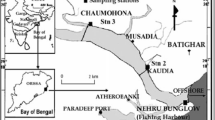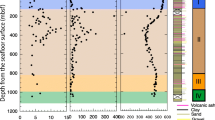Abstract
Volcanic activity is one of the primary sources of arsenic in nature, and chemical forms of arsenic discharged by volcanic activity are inorganic. Kagoshima Bay has active submarine volcano located in the 200 m deep basin of its northern part. Since dissolved inorganic arsenic is more toxic than organic arsenic it is important to understand the dispersion of discharged arsenic in seawater. To estimate the influence of arsenic emitted from the bottom vents seasonal changes in As(III) and As(V) concentrations in seawater were studied. There are few studies on the impact of arsenic discharged by submarine volcanos in the inner bay. The total concentrations of As(III) and As(V) (T-As) in seawater at the background site in Kagoshima Bay was 1.71 ± 0.35 μg L−1 (av. ± s.d.), similar to the world average value of 1.7 μg L−1. The highest T-As value at the nearest point to the submarine volcano, 3.48 μg L−1, was observed in summer. Since the vertical mixing of seawater cannot occur in summer due to the formation of the thermocline, the deep water is strongly affected by volcanic activity. The increase in T-As was caused by the increase in As(III) concentration suggesting the discharge of As(III) from the vents.






Similar content being viewed by others

References
Adachi, T., Oyama, T., 2009. Residual current and water exchange at Nishisakura-jima Strait in Kagoshima Bay. J. Jpn. Soc. Civ. Eng. Ser. B2 (Coast. Eng.) B2–65, 421–425 (in Japanese with English Abstract).
Arakami S (1984) Formation of the Aira Caldera, Southern Kyushu, ~22,000 years ago. J Geophys Res 89:8485–8501
Baba A, Sözbilir H (2012) Source of arsenic based on geological and hydrogeochemical properties of geothermal systems in Western Turkey. Chem Geol 334:364–377
Breuer C, Pichler T (2013) Arsenic in marine hydrothermal fluids. Chem Geol 348:2–14
Byrd JT (1988) The seasonal cycle of arsenic in estuarine and nearshore waters of the South Atlantic Bight. Mar Chem 25:383–394
Feely RA, Trefry JH, Massoth GJ, Metz S (1991) A comparison of the scavenging of phosphorus and arsenic from seawater by hydrothermal iron oxyhydroxides in the Atlantic and Pacific Oceans. Deep-Sea Res 38(6):617–623
Hasegawa H (1996) Seasonal changes in methylarsenic distribution in Tosa Bay and Uranouchi Inlet. Appl Organometal Chem 10:733–740
Hasegawa H, Sohrin Y, Seki K, Sato M, Norisuye K, Naito K, Matsui M (2001) Biosynthesis and release of methylarsenic compounds during the growth of freshwater algae. Chemosphere 43:265–272
Ishibashi J, Nakaseama M, Seguchi M, Yamashita T, Doi S, Sakamoto T, Shimada K, Shimada N, Noguchi T, Oomori T, Kusakabe M, Yamanaka T (2008) Marine shallow-water hydrothermal activity and mineralization at the Wakamiko crater in Kagoshima bay, south Kyushu, Japan. J Volcanol Geoth Res 173:84–98
Kamada M, Sakamoto H, Yonehara N, Ohnishi T (1977) Unusual property of water in the bay head Area of Kagoshima Bay. Submarine volcanic activities and environmental anomalies in the bay head area, the northern part of Sakurajima, pp 64–80. (in Japanese)
Li C, Kang S, Chen P, Zhang Q, Mi J, Gao S, Sillanpää M (2014) Geothermal spring causes arsenic contamination in river waters of the southern Tibetan Plateau. China Environ Earth Sci 71:4143–4148
Li L, Ren JL, Cao XH, Liu SM, Hao Q, Zhou F, Zhang J (2017) Process study of biogeochemical cycling of dissolved inorganic arsenic during spring phytoplankton bloom, southern Yellow Sea. Sci Total Environ 593–594:430–438
Mitchell P, Barr D (1995) The nature and significance of public exposure to arsenic: a review of its relevance to South West England. Environ Geochem Health 17:57–82
Neff JM (1997) Ecotoxicology of arsenic in the marine environment. Environ Toxicol Chem 16:917–927
Oki K (1989) Ecological analysis of benthonic foraminifera in Kagoshima Bay, South Kyushu. Japan S Pac Study 10:1–191
Peterson ML, Carpenter R (1983) Biogeochemical processes affecting total arsenic and arsenic species distribution in an intermittently anoxic fjord. Mar Chem 12:295–321
Price RE, Amend JP, Pichler T (2007) Enhanced geochemical gradients in a marine shallow-water hydrothermal system: unusual arsenic speciation in horizontal and vertical pore water profiles. Appl Geochem 22:2595–2605
Price RE, London J, Wallschläger D, Ruiz-Chancho MJ, Pichler T (2013) Enhanced bioaccumulation and biotransformation of As in coral reef organisms surrounding a marine shallow-water hydrothermal vent system. Chem Geol 348:48–55
Rahman MA, Hasegawa H, Lim RP (2012) Bioaccumulation, biotransformation and trophic transfer of arsenic in the aquatic food chain. Environ Res 116:118–135
Ruiz WLG, Tomiyasu T (2015) Distribution of mercury in sediments from Kagoshima Bay, Japan, and its relationship with physical and chemical factors. Environ Earth Sci 74:1175–1188
Sakamoto H (1985) The distribution of mercury, arsenic, and antimony in sediments of Kagoshima Bay. Bull Chem Soc Jpn 58:580–587
Sakamoto H, Tomiyasu T, Yonehara N (1990) The contents and distriburions of arsenic, antimony and mercury in the rivers and the hot spring sediments that flow into the northern Kagoshima Bay. Rep Fac Sci Kagoshima Univ Math Phys Chem 23:159–167
Sanders JG, Windom HL (1980) The uptake and reduction of arsenic species by marine algae. Estuar Coast Mar Sci 10:555–567
Stauffer RE (1984) Arsenic and antimony in geothermal waters of Yellowstone National Park, Wyoming, USA. Geochim Cosmochim Acta 48:2547–2561
Tomiyasu T, Minato T, Ruiz WLG, Kodamatani H, Kono Y, Hidaka M, Oki K, Kanzaki R, Taniguchi Y, Matsuyam A (2015) Influence of submarine fumaroles on the seasonal changes in mercury species in the waters of Kagoshima Bay. Japan Mar Chem 177:763–771
World Health Organization, 2017, Guidelines for drinking-water quality: fourth edition incorporating the first addendum, pp 315–318.
Yamanaka T, Maeto K, Akashi H, Ishibashi J, Miyoshi Y, Okamura K, Noguchi T, Kuwahara Y, Toki T, Tsunogai U, Ura T, Nakatani T, Maki T, Kubokawa K, Chiba H (2013) Shallow submarine hydrothermal activity with significant contribution of magmatic water producing talc chimneys in the Wakamiko Crater of Kagoshima Bays, Southern Kyushu, Japan. J Volcanol Geoth Res 258:74–84
Acknowledgments
This work was supported by Grants-in-Aid (No. 19H01168) for Scientific Research from the Japan Society for the Promotion of Science (JSPS).
Funding
This work was supported by Grants-in-Aid (No. 19H01168) for Scientific Research from the Japan Society for the Promotion of Science (JSPS).
Author information
Authors and Affiliations
Corresponding author
Ethics declarations
Conflict of interest
On behalf of all authors, the corresponding author states that there is no conflict of interest.
Additional information
Publisher's Note
Springer Nature remains neutral with regard to jurisdictional claims in published maps and institutional affiliations.
Supplementary Information
Below is the link to the electronic supplementary material.
Rights and permissions
About this article
Cite this article
Tomiyasu, T., Nakagawa, M., Kodamatani, H. et al. The influence of submarine volcano on seasonal changes in arsenic in the waters of Kagoshima Bay, southwestern Japan. Environ Earth Sci 80, 331 (2021). https://doi.org/10.1007/s12665-021-09619-1
Received:
Accepted:
Published:
DOI: https://doi.org/10.1007/s12665-021-09619-1



